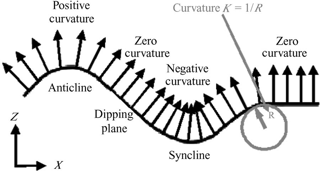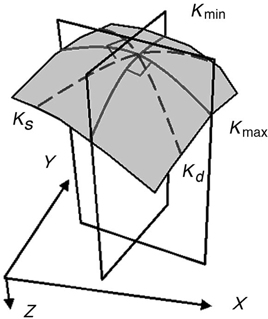Curvature is a second order measure which is unaffected by the local surface orientation but measures the variation in that orientation and is very useful in characterising surface shape or the local surface topology as you might otherwise call it. The curvature value shows you how deformed a surface is, with high values indicating tighter curves (more deformation) and lower values indicating less curve (flatter events).
The measures of curvature that are commonly taken include:
- Kmax - Maximum Curvature – looking along all tangents to the surface, which is the biggest absolute curvature to be found.
- Kmin - Minimum Curvature – the curvature measured along a direction at right angles to the direction of maximum curvature.
- Kmean - Mean Curvature - ((max + min) / 2).
- Kg -Gaussian Curvature – (max * min)
- Kpos – Most positive Curvature
- Kneg – Most negative Curvature
- Kdip – Curvature along dip
- Kstrike – Curvature along strike
- Shape Index – provides distinct values based on the form of the local surface shape.
- Direction of Max Curvature – the vector pointing along the direction in which the maximum curvature lies.
- Direction of Min Curvature – the vector pointing along the direction in which minimum curvature lies.
Geoteric’s Flexure Attribute
Often published are Most Positive (K pos ) and Most Negative (K neg ) curvature. This shows where there is the most positive (or negative) deformation in any orientation.
Geoteric outputs Dip Curvature (K dip ) and Strike Curvature (K strike ) as well as the combined Flexure attribute which is the sum of the two curvatures (K dip + K strike ). This shows the most positive and the most negative curvature along the dip and/or strike planes.
Dip and Strike curvature have the advantage that they show both positive and negative curvature in the same volume (anticlines and synclines). Most Positive and Most Negative curvature will only show anticlines (K pos ) or synclines (K neg ), not both simultaneously. However if the strongest curvature is not along the dip or strike planes then the value of the curvature displayed in a combined Flexure volume will not represent the tightest part of the curve.
The Flexure attribute calculates the pole vectors for each point based on the dip and azimuth volumes.
This is how the pole vectors will look in different circumstances.
The number of vectors calculated in the footprint is set by the Filter Size, and calculate the curvature in the dip and strike orientations (ie. kdip and Kstrike).
Care must be taken when choosing the Filter Sizes. It should be smaller than the smaller scale structure in the data, this filter will not scale as expected and larger scale DipAzimuth filters should be used as input, when attempting to measure larger scale structures in the data
Note: Geoteric’s value convention is the opposite to some definitions (but the same as others). In Geoteric an Anticline has a negative value (blue) and a Syncline has a positive value (red).




